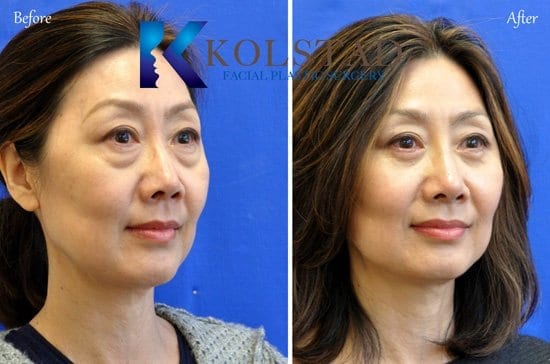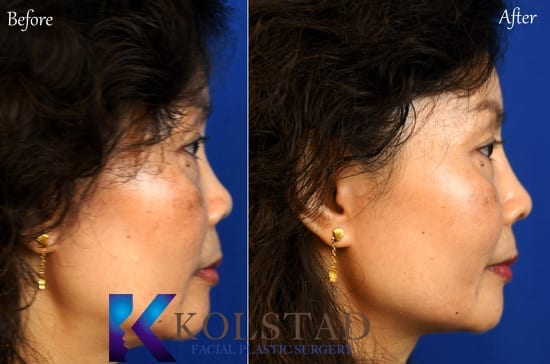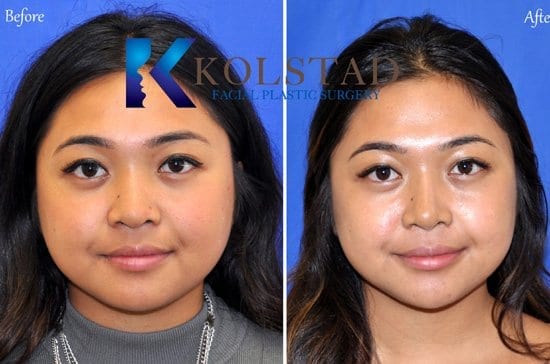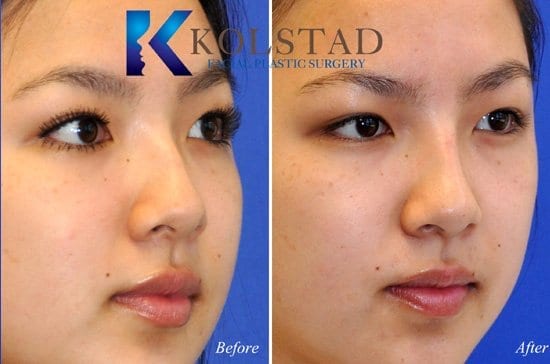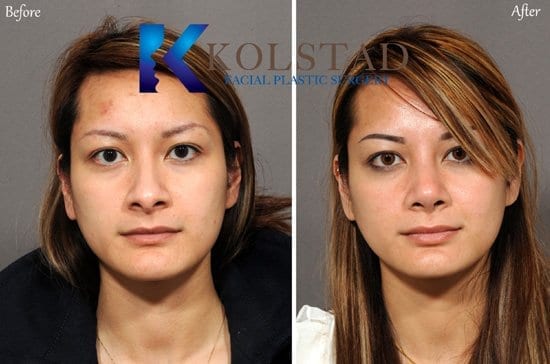Asian Nose Job Specialist | San Diego Asian Rhinoplasty Surgeon
Asian rhinoplasty is one of Dr. Kolstad’s most common procedures. San Diego has a diverse community with people from every part of the world. Many nose job surgeons will have the same rhinoplasty result for every face. Dr. Kolstad specializes in achieving unique results that match your features as well as your ethnic background.
How Are Asian Noses Different From Those Of Other Ethnicities?
Many of our Asian rhinoplasty patients in San Diego are not looking to make a large dorsal hump smaller, but instead are seeking to augment a small nasal bridge. They are seeking refinement of the nasal tip, without it looking too narrow. Above all, they seek to retain the features unique to their ethnicity.
The goal of San Diego Asian rhinoplasty is simple: to enhance one’s natural features and refine the others in a way that balances the nose in harmony with the rest of the face. Achieving this goal is best performed by the hands of a specialist. When examining a nose it is helpful to evaluate the individual subunits.
Nasal Tip:
Asian noses can have tips that are often wide and prominent on the front view. By reshaping the nasal tip cartilages the nose will appear more refined and in better balance with the other facial features. Asian noses typically require significantly less excision of nasal tip cartilage (cephalic trim). Most commonly refinement can be achieved by increasing the projection of the nasal tip.
Asian nasal tips have are typically less projected than other ethnicities. By pushing the nasal tip outwards (increasing projection) the nose will appear more narrow and refined. Dr. Kolstad’s preferred way of adding projection is by using cartilage. The most common source of the required cartilage is the septum. Auricular (ear) and costal (rib) cartilage are secondary choices. Dr. Kolstad does not use L-shaped nasal implants to increase the nasal tip projection. L-shaped implants are easy for surgeons to place but can lead to disastrous outcomes if they protrude through the nasal skin.
Columella:
A hanging columella (the strip of skin between the nostrils) is a cause of a drooping nasal tip. Columellar ptosis can be corrected at the time of rhinoplasty to improve the infratip lobule (the lower part of the nasal tip). Reducing a hanging columella will make the nose appear less elongated on the profile view and less drooping on the front view.
Asian noses will frequently have a retracted columella (no visible strip of skin between the nostrils). A retrused columella can be corrected by adding cartilage to the nose. Typically a septal extension graft is used in combination with bilateral spreader grafts to create a more appealing columella.
Bridge:
Asian noses can have a prominent hump on the bridge. The hump or convexity is most visible on the profile view. Reducing the prominence of the hump can make a significant impact on the overall appearance of the nose.
Asian noses can also have very low projection of the bridge. A flat nasal bridge can lead to challenges wearing glasses that require nasal support. Adding height to the bridge will make the nose appear more slender and more refined. Dr. Kolstad prefers to use either rib cartilage or silicone dorsal onlay implants to add height to the bridge.
Radix:
The radix is the highest part of the bridge of the nose. Asian noses tend to start lower on the radix of the nose, typically level with the pupil of the eye. Caucasian noses start higher on the radix, around the height of the upper eyelid.
A common trend in Korean rhinoplasty is to make the starting point higher on the radix. By moving the nasal starting point from the midpupil to the upper eyelid the nose will appear longer and straighter. If the starting point is moved too high on the radix an unnatural, plastic appearance can be created.
Asian Rhinoplasty San Diego
Case #1.
This patient did not like the shape or proportion of her nose. She felt like the bridge was too small on profile view. She was concerned that the tip of her nose was over rotated and created too much nostril show.
Dr. Kolstad used rib cartilage to add height to the bridge of her nose and restructure her nasal tip. The nose was rotated downwards creating a more natural contour and nostril balance.
Rib Cartilage Asian Nose Job San Diego
Case #7.
This San Diego Asian rhinoplasty patient wanted to improve the shape and balance of her nose. She felt like the bridge was too small on profile view. She wanted a tip that projected further and was more refined.
Dr. Kolstad used rib cartilage to add height to the bridge of her nose and restructure her nasal tip. The nose was made higher, longer and more narrow through complex cartilage grafting.
San Diego Asian Rhinoplasty Using Implant
Case #21.
The patient felt that her nose was too wide and without definition. During her rhinoplasty consultation multiple methods and techniques were discussed to achieve her goals. She decided to pursue an implant to increase the height of the bridge of her nose. The nasal tip was reshaped using cartilage from her septum. The nostrils and alar base were made less wide.
Asian Rhinoplasty
Not Ready For Surgery? Consider Liquid Rhinoplasty
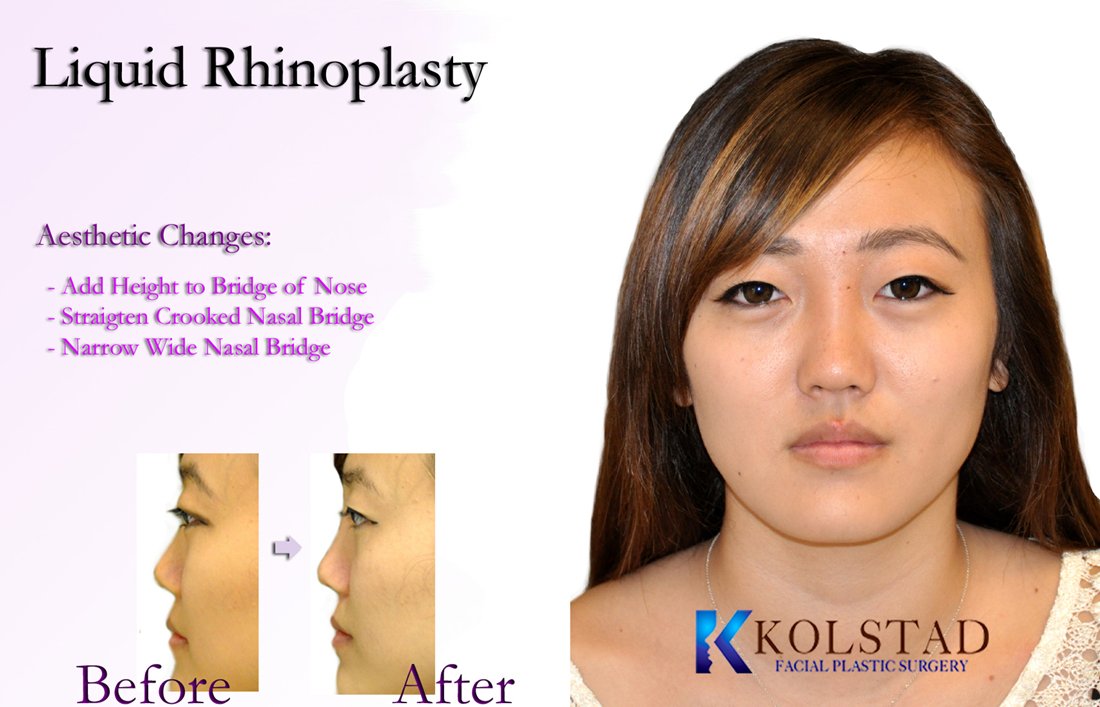
Nonsurgical rhinoplasty is a procedure performed in the office to increase the size of a nasal bridge or soften a nasal hump. This procedure is most often sought by Asian and African American patients looking to add volume and definition to the part of the nose that rests between the eyes.
Adding volume to a diminutive nasal bridge can have a dramatic impact on the entire face. Injectable rhinoplasty is most noticeable on profile view. Nonsurgical rhinoplasty can soften a nasal hump or add volume to a small nasal bridge.
WHAT CAN BE CORRECTED WITH LIQUID RHINOPLASTY:
- A nasal bridge with a hump can be straightened
- A nasal bridge that is scooped
- A bridge that is too small at the root of the nose (between the eyes)
WHAT CANNOT BE CORRECTED WITH LIQUID RHINOPLASTY:
- A wide nasal tip
- Nostrils that are too large
- Typically injectable fillers such as Juvederm, Restylane or Radiesse are expertly placed into the nasal bridge. The results can last up to a year depending on the amount and product used. Dr. Kolstad can frequently illustrate potential changes using computer-enhancement software before you have to decide if it is the right look for you.
Asian Liquid Rhinoplasty San Diego
Case #28.
Not everyone that wants to changes the shape of the nose needs surgery. Nonsurgical “liquid” rhinoplasty is a popular choice for many of our rhinoplasty patients.
This patient wanted to straighten the bump on her nose. Dr. Kolstad used Juvederm to add height to the top of her bridge making the nose straighter and more feminine.
Injectable Rhinoplasty San Diego
Case #47.
Not everyone that wants to changes the shape of the nose needs surgery. Nonsurgical “liquid” rhinoplasty is a popular choice for many of our rhinoplasty patients.
This patient wanted to make her nose higher and more narrow. Dr. Kolstad used Juvederm to add height to the top of her bridge making the nose straighter and more feminine.
Asian Rhinoplasty
Frequently Asked Questions
It takes two to three weeks for the majority of swelling to be reabsorbed from your nose. As the swelling is removed, your nose will become more contoured and the definition will enhance.
It is very important to choose a plastic surgeon that specializes in operating on the face. Dr. Kolstad is an expert in nasal cosmetic surgery and is known as the face specialist, because put simply, that is all he does.
Contact Us
To schedule an appointment call us at (858) 859-2563 or get in touch with the form below.


